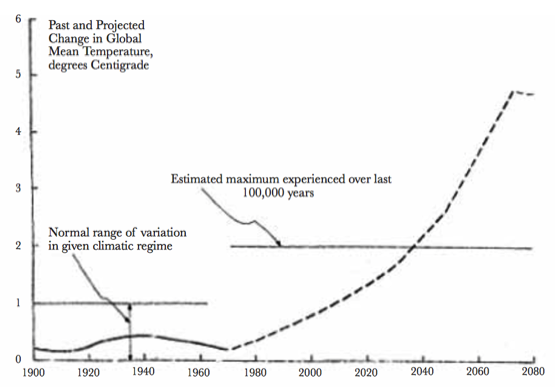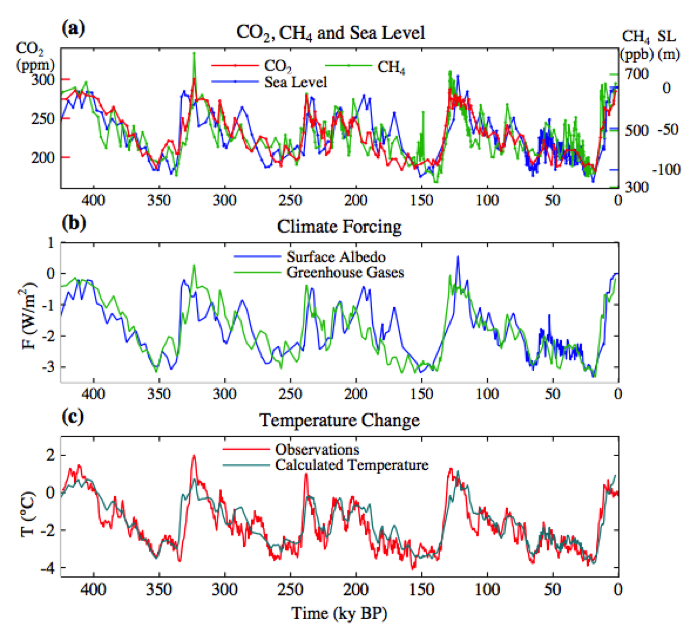
2C or not 2C
The curious history of the two-degree safety fence for global warming
The idea of limiting global warming to less than two degrees is so routine now that you could be forgiven for thinking it’s a well worked out scientific principle - but it’s not. And there’s been a growing rumble of discontent among scientists, specially since a brief article in Nature last year by David Victor & Charles Kennel, and another this year by Oliver Geden.
Both essays make two important points: there are very good reasons for believing the two degree limit is now practically out of reach; and the target is a figment, an abstraction located in the future, a step or two removed from the kind of concrete, observable goal that is needed to motivate governments and policy makers.
“The best indicator has been there all along”, Victor & Kennel wrote, “the concentrations of CO2 and the other greenhouse gases (or the change in radiative forcing caused by those gases)”. These are continuously measured, accessible, cogent, and their meaning in terms of policy progress or otherwise is now patently clear to everyone. Why haven’t we been using them instead, they ask. The answer seems to be: politics.
Needless to say, these views weren’t shared by all. Still, these scientists were not the first to voice alarm at the way decision makers have been treating the 2℃ limit creatively. Kevin Anderson at UK’s Tyndall Centre has been explaining just how challenging two degrees really is for some years. James Hansen realised that advances in paleoclimatology had shown it to be unsafe by the time he published his Target Atmospheric CO2 paper in 2008.
You may be surprised to know that the first person to advocate a two degree limit for warming was an economist, not a scientist, and he published his view in 1975.
“As a first approximation, it seems reasonable to argue that the climatic effects of carbon dioxide should be kept within the normal range of long-term climatic variation. According to most sources the range of variation between distinct climatic regimes is in the order of 5°C, and at the present time the global climate is at the high end of this range. If there were global temperatures more than 2 or 3° above the current average temperature, this would take the climate outside of the range of observations which have been made over the last several hundred thousand years”.
[Nordhaus, W.D. (1977) Strategies for the Control of Carbon Dioxide. Connecticut, Cowles Foundation for Research in Economics at Yale University].
At that time, of course, no scientist or economist had any idea what a safe level of warming would be. Nordhaus published this diagram to back up his reasoning, which, considering the state of knowledge, turned out to be fairly perceptive. Just the same, the idea only entered the arena of climate politics and diplomacy as a key metric twenty years later, and wasn’t officially adopted in the way we understand it now until the COP16 UNFCCC conference in Cancun Mexico in 2010.
Is it really safe? This isn’t a scientific question because it needs an evaluation of the concept of danger, so scientists approach it by way of another question: what was it like on Earth last time it was 2℃ hotter? The question can then be directed at paleoclimatologists - practitioners in a cluster of specialities whose results contribute to building up a history of Earth’s climate over thousands, and millions of years.
Climate history has become an incredible scientific success story in the last 30 years, spurred along by the immense importance of finding good answers to such questions. And others, like: when was the last time CO2 was 400 ppm? And when did CO2 rise as fast as it is doing now? And how did Greenland respond last time it was a degree or two warmer?
So do we know when it was last 2℃ warmer, and what it was like then? Yes, we do. Not with the kind of precision you’d expect from a political historian, but quite precise enough to be a very useful guide for managing the climate problem.
The most accurate reconstructions of the climate past come from ice cores. An example of what can be inferred from them is given below. The longest core drilled to date was extracted between 1996 and 2005 high on the Antarctic plateau by members of the EPICA project. The drill reached the bottom of the ice sheet at a depth of 3,270 metres, where the ice turned out to be 820,000 years old - so this is the limit of the high-precision record. From it we know with great confidence that the world has never been 2℃ warmer in all that time.

(a) principal greenhouse gases & sea-level; (b) forcing - the strength of all influences on Earth’s energy balance; (c) temperature - Antarctic air temperature and calculated global mean temperature. Hansen et al, 2008; The Open Atmospheric Science Journal, 2, 217-231

William Nordhaus
sketch of hypothetical future warming 1977
Where do paleoclimatologists look next? Well, (if this is news to you, it should be surprising) from cores of mud drilled on the ocean floor. A deep ocean drilling program going back 60 years has given researchers a vast archive of these specimens, which, with very patient and ingenious probing, can yield a remarkable amount of information about Earth’s past.
We owe our answer to a couple of young scientists who published a careful synthesis of ocean core data in 2005, giving us a highly resolved record of the last 5.3 million years (the Pliocene epoch). The graph below is adapted from their paper.
It shows Earth close to 2℃ warmer in about the middle Pliocene, 3 million years ago, and as you’d expect, this period has had a fair bit of attention from investigators. Finding the sea-level and atmospheric composition for times as remote as this isn’t easy, but the convergence of evidence strongly suggests that the sea was between 15 and 25 metres higher than it is now; and CO2 was in the range 360 - 400 ppm - in other words. close to its present value.
Putting it another way, the science of paleoclimatology has allowed us to see that William Nordhaus was a little optimistic all those years ago; and there’s a case to be made that, as a rhetorical focus for climate diplomacy, two degrees has gotten a bit out of hand.
Knowing what we do, it might be better if decision makers focussed instead on this stark fact - that if the present concentration of CO2 were sustained for long enough, we should expect the sea to rise inexorably for centuries until our descendants had to abandon everything we’ve built along every shore and estuary and coastal plain in the world.
We might then agree with Kevin Anderson & Alice Bows who concluded their sobering 2008 study with this thought,
“the rhetoric of 2℃ is subverting a meaningful, open and empirically informed dialogue on climate change. While it may be argued that 2℃ provides a reasonable guide to the appropriate scale of mitigation, it is a dangerously misleading basis for informing the adaptation agenda.”
Hansen’s paper is here: http://arxiv.org/pdf/0804.1126)
Lisiecki & Raymo’s study is here: http://large.stanford.edu/publications/coal/references/docs/Lisiecki_Raymo_2005_Pal.pdf
Anderson & Bows’ study is here: http://www.climateemergencyinstitute.org/uploads/anderson_bows_reframing_post_2000_emissions_08.pdf
Victor, D & Kennel, C, 2014; Nature, 514, 30-31.
Geden, O, 2015; Nature, 521, 27-28.

Adapted from Lisiecki & Raymo, 2005; Paleoceanography, 20, PA1003
On the temperature scale, zero is the Holocene mean
October 5th 2015

